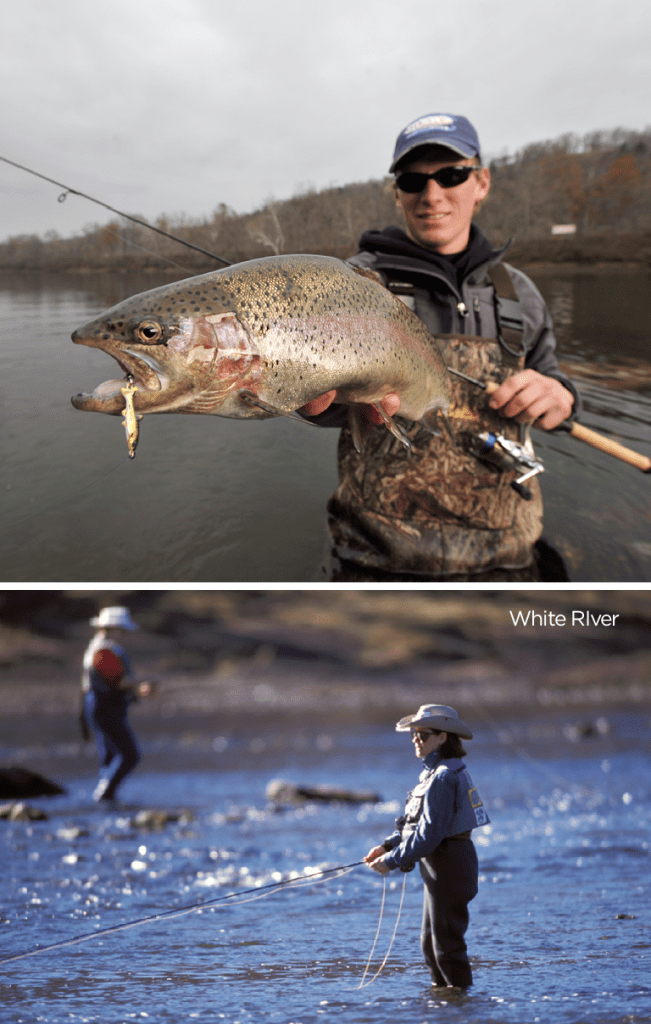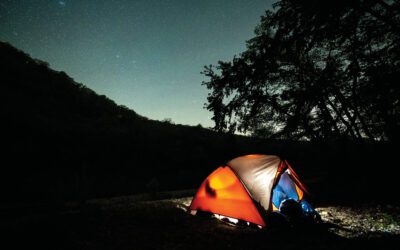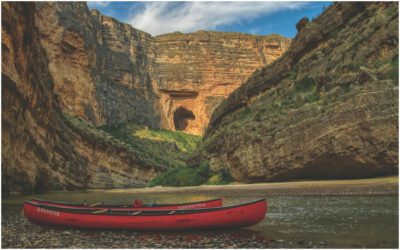[title subtitle=”words: Dwain Hebda
Images: Dwain Hebda and Arkansas Department of Tourism”][/title]
Throughout all of the Natural State’s varied ecosystems—mountains, swamps, Delta, woods—the White River areas stand out for relaxing vistas and excellent fish and game. More than half a million fishing licenses were sold in Arkansas alone in 2017 and while it’s impossible to know how many license holders dropped a line where, it’s a fair bet that many found their way to the White River, along with countless visitors from out of state.
In Arkansas’ hierarchy of waterways, the Mississippi is the undisputed king in terms of size and significance, followed by the Arkansas River that bisects the state rolling west to east. But right up there is the White River, a 722-mile north-south ribbon of water of enormous economic and ecological importance.
Unlike its two companions, the White River can be rightfully claimed as ours, birthed as she is as a mountain spring in the Boston Mountains near Fayetteville (the Arkansas originates in the Rockies, Mighty Miss in Minnesota). Proud and headstrong, she flows north for a spell feeding Missouri’s Table Rock Lake and Lake Taneycomo via a system of dams there and giving vacationers in Branson some recreation. But she quickly turns back south into the arms of Bull Shoals Dam and Lake.
 Bull Shoals is a shimmering jewel and no small feat of engineering, either. The lake was created with the completion of Bull Shoals Dam, one of several dams in the White River Basin greenlighted by Congress in the wake of devastating floods. Constructed between 1947 and 1951, the 2,256-foot-long dam soars 265 feet above the creek bed.
Bull Shoals is a shimmering jewel and no small feat of engineering, either. The lake was created with the completion of Bull Shoals Dam, one of several dams in the White River Basin greenlighted by Congress in the wake of devastating floods. Constructed between 1947 and 1951, the 2,256-foot-long dam soars 265 feet above the creek bed.
Peering down on this majestic structure from the glittering James A. Gaston Visitor’s Center of Bull Shoals-White River State Park, and the tranquil, curvaceous slip of the river that extends from the dam’s spillway, it’s hard to appreciate the fury with which the wild river once flowed. In the Great Flood of 1927, heavy Canadian snow melt combined with a torrentially wet spring to send the Mississippi over its banks to back up the White, along with the Arkansas and St. Francis Rivers. So ferocious was the rush of the Mississippi’s largesse, it caused the White to run backwards for a time.
Modern water management has changed all that and created a recreational wonderland in the process. Bull Shoals Lake, on the border between Baxter and Marion counties, boasts about 740 feet of shoreline, 45,000 surface acres of water and a capacity of nearly 6-million acre feet (one acre foot equals 326,000 gallons). All of these facts and more are on display at the 16,000-square-foot visitor’s center, a must during any visit to the area as is a drive across the top of the dam.
The White River may emerge from the Bull Shoals Dam much more docile than her wilder days, but she’s no less appealing to anglers. The lake is home to catfish, crappie, and bream and prized nationally for its bass while the tailwaters of the White here and below Norfolk Dam to the southeast are considered the best trout fishing in mid-America.
Trout are not indigenous to Arkansas, but were introduced here after the discharge from the dams proved too cold for native fish. Brown trout and rainbow trout have done particularly well although only brown trout have successfully bred in these waters; rainbow trout are stocked annually.
As fishing enthusiasts come from all over the country to try their luck on the upper White River, it’s spawned outdoor tourism that’s an important source of revenue for local economies. Guide services, fishing lodges and resorts, from bare-bones rustic to swank, are in abundance here, the most famous of which—Gaston’s White River Resort—is a short drive from the dam.
Gaston’s is among the oldest (established 1958) and most developed of the accommodations in the area, complete with an on-premises conference center and its own grass airstrip. Even if you’re not staying on-site, consider a guided fishing trip, fly-fishing lesson or just grab lunch or dinner in Gaston’s award-winning restaurant. They even cook your day’s catch.
 As the White continues its route southeasterly through the area, it curls and bends its way through hairpins and horseshoes that become the stuff of fishing legend. Many small towns in the region play second fiddle to the river; take Cotter and next-door Gassville for example. Combined, the two communities didn’t break 3,000 residents on the last census, but that doesn’t stop them from advertising themselves as the epicenter of the trout universe—in Cotter’s case, literally, “Trout City USA.” Snuggled into a U-bend in the White River providing outstanding access, the overflow of anglers and nature lovers is enough to keep both towns happy.
As the White continues its route southeasterly through the area, it curls and bends its way through hairpins and horseshoes that become the stuff of fishing legend. Many small towns in the region play second fiddle to the river; take Cotter and next-door Gassville for example. Combined, the two communities didn’t break 3,000 residents on the last census, but that doesn’t stop them from advertising themselves as the epicenter of the trout universe—in Cotter’s case, literally, “Trout City USA.” Snuggled into a U-bend in the White River providing outstanding access, the overflow of anglers and nature lovers is enough to keep both towns happy.
Though much smaller in size, the fame of the Buffalo River as a recreation attraction leads some to think it’s the White’s peer waterway. In fact, the Buffalo is a tributary of the White, the two coming together about half an hour west of Norfolk at Buffalo City. Lodges located near this confluence, such as the White Buffalo Resort, provide the unique experience of fishing both rivers which support different species.
The Buffalo River is the nation’s first national river and prized by generations of Arkansans who have floated its gentle current. It’s also considered one of the most significant wins for conservationists in the history of the state. The same measures that resulted in Bull Shoals Dam originally targeted the Buffalo as well, dam proposals successfully opposed by “free stream” naturalists, thus keeping the river wild.
The White has also been caught between commerce and conservation during its lifetime, particularly in the lower White River area that cuts through the Grand Prairie region of Arkansas en route to the Mississippi. Here, the river takes on more commercial applications, watering rice fields and providing a means for transport. Separate proposals for large-scale pumping for agricultural purposes and deepening a channel to increase barge traffic are recent battles that as of this writing have yet to be resolved.
Visitors to the lower White River on the Delta will want to visit the Dale Bumpers White River Wildlife Refuge east of DeWitt. The refuge protects important and endangered wetland ecosystems including southern bottomland hardwood forest (The Big Woods) and native grasslands. Black bears have made a comeback thanks to the refuge, which is also home to a dizzying array of Arkansas bird species from mallard duck to bald eagle. The sighting of the fabled Ivory Bill Woodpecker – the sasquatch of birds – happened here too.
From clear-running mountain waters to broad, meandering stretches, the White River reflects the many faces of our state, providing its lifeblood in more ways than one. A visit along any part of it is a singular chapter in the story of Arkansas and its people.
Bull Shoals-White River State Park
Arkansasstateparks.com/bullshoalswhiteriver
870.445.3629
Dale Bumpers White River National Wildlife Refuge
fws.gov/refuge/white_river
870.282.8200




